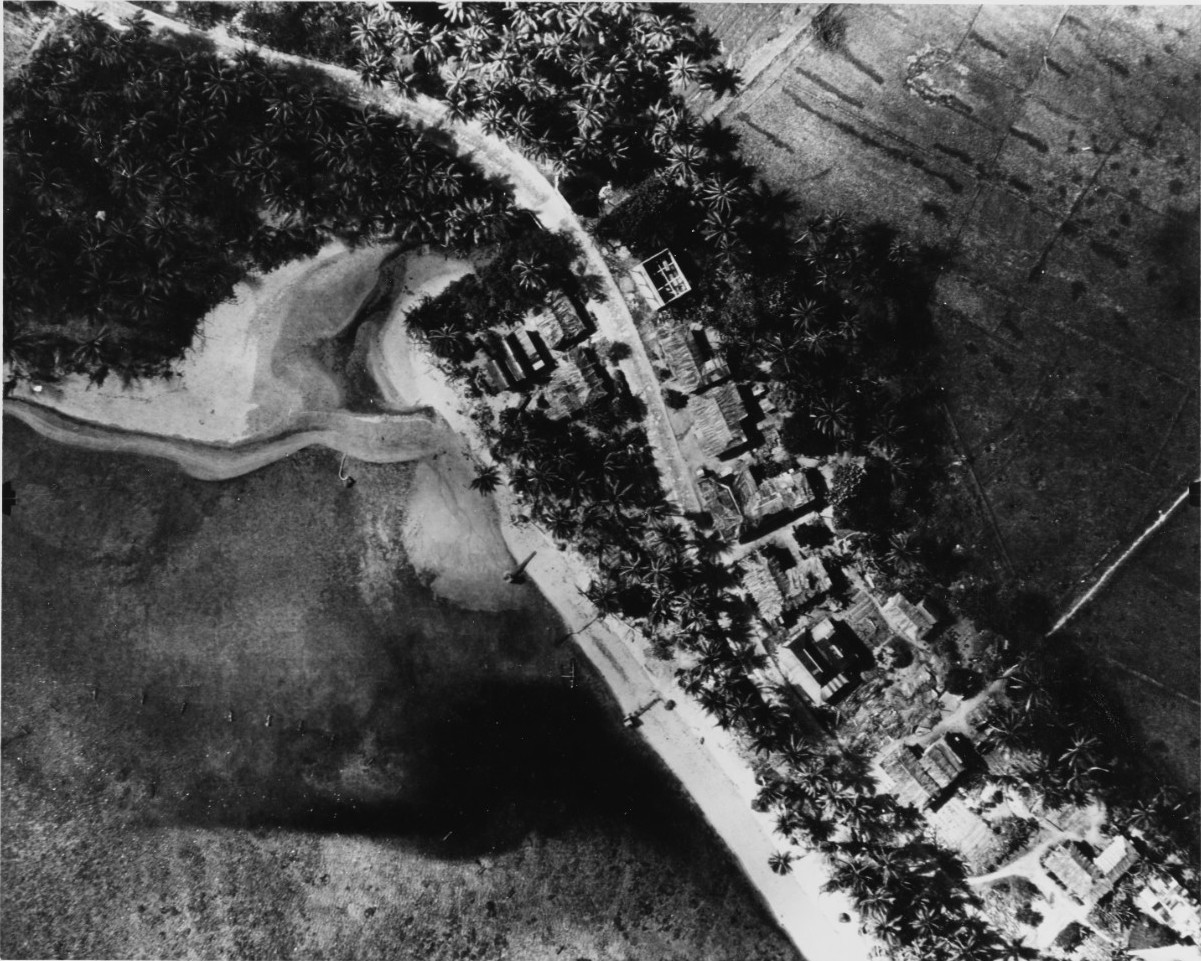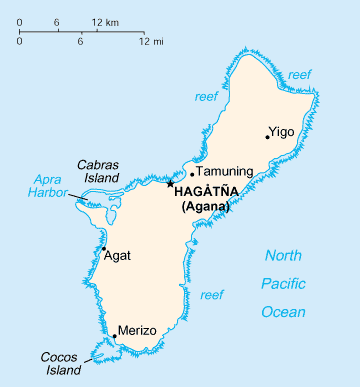|
Asan Invasion Beach
The Asan Invasion Beach is a historic site in the village of Asan, Guam. The beaches of Asan were one of the landing sites of American forces in the 1944 Battle of Guam, in which the island was retaken from occupying Japanese forces. The designated historic site includes the beaches extending between Asan Point and Adelup Point, and extends inland roughly to Guam Highway 1. It also includes the water area extending from the beach to the reef, about out, an area that includes at least one abandoned Allied landing vehicle. The beaches, fortifications, and water out to the reef were listed on the National Register of Historic Places in 1979. Portions of them are part of the Asan Beach Unit of the War in the Pacific National Historical Park, which includes a public access point at Asan Point. Just east of this is Memorial Beach Park, a municipal beachfront park that was listed on the National Register in 1974. See also *National Register of Historic Places listings in Guam __N ... [...More Info...] [...Related Items...] OR: [Wikipedia] [Google] [Baidu] |
Landing Craft Infantry
The Landing Craft Infantry (LCI) were several classes of landing craft used to land large numbers of infantry directly onto beaches during the Second World War. They were developed in response to a British request for seagoing amphibious assault ships capable of carrying and landing substantially more troops than their smaller Landing Craft Assault (LCA). The result was a small steel ship that could land 200 men, traveling from rear bases on its own bottom at a speed of up to 15 knots. Some 923 were built starting in 1943, serving in both the Pacific and European theaters, including a number that were converted into heavily armed beach assault support ships. The LCI(L) supplemented the small LCAs/ LCVPs as a way to get many troops ashore before a dock could be captured or built. As such, they were the largest dedicated beachable infantry landing craft (the larger Landing Ship Infantry (LSI) was a transporter for men and small craft such as the British LCA) in the Allied inventory ... [...More Info...] [...Related Items...] OR: [Wikipedia] [Google] [Baidu] |
Asan, Guam
Asan is a community and census-designated place (CDP) along the western coast of the U.S. territory of Guam. Asan, along with Maina and Nimitz Hill Annex, are the three communities in the village of Asan-Maina. - See "Asan muny" It is known for being the location of northern invasion beach used by the United States during the retaking of Guam in 1944. Geography Asan lies along the western coast of Guam along Asan Bay, facing the Philippine Sea. It is completely surrounded by the Asan Beach Unit and Asan Inland Unit of War in the Pacific National Historical Park. The village lies between Asan Point and Adelup Point. Guam Highway 1, better known as Marine Corps Drive, provides access to Piti to the west and Maina to the east. Nimitz Hill Annex on the Nimitz Hill highlands inland of Asan is not directly accessible by road. The Asan River flows through the western part of the community. A distinguishing feature is the large grassy park at Asan Point, which is actually across Ma ... [...More Info...] [...Related Items...] OR: [Wikipedia] [Google] [Baidu] |
Battle Of Guam (1944)
The Battle of Guam (21 July–10 August 1944) was the American recapture of the Japanese-held island of Guam, a U.S. territory in the Mariana Islands captured by the Japanese from the United States in the First Battle of Guam in 1941 during the Pacific campaign of World War II. The battle was a critical component of Operation Forager. The recapture of Guam and the broader Mariana and Palau Islands campaign resulted in the destruction of much of Japan's naval air power and allowed the United States to establish large airbases from which it could bomb the Japanese home islands with its new strategic bomber, the Boeing B-29 Superfortress. Background Guam, at 212 square miles (543 square kilometers), is the largest island of the Marianas, with a length of 32 miles (52 km) and a width ranging from 12 miles (19.31 km) to four miles (6.44 km) at different points of the island. It had been a United States possession since its capture from Spain in 189 ... [...More Info...] [...Related Items...] OR: [Wikipedia] [Google] [Baidu] |
Asan Point
Asan () is a city in South Chungcheong Province, South Korea. It borders the Seoul Capital Area to the north. Asan has a population of approximately 300,000. Asan is known for its many hot springs and is a city of spas. Asan has grown into the neighboring village, Onyang-dong, which is also known for its hot springs. Climate Transportation The city of Asan shares a station for the KTX high speed trains with the directly adjacent city of Cheonan, which is thusly named Cheonan-Asan Station. It takes about 30 minutes to travel from Asan to Seoul by the KTX train. It can be reached within 2 hours from Incheon International Airport by car. Seoul Metropolitan Subway extended one of its lines to service Asan on 15 December 2008. Two major highways, the Seoul-Busan and West Coast expressways, also pass through Asan city. Industry and commerce Companies like Hyundai Motor, Samsung LCD, and Samsung Electronic have factories in Asan. A total of 14 industrial complexes are cur ... [...More Info...] [...Related Items...] OR: [Wikipedia] [Google] [Baidu] |
Adelup Point
Adelup Point is limestone promontory in Hagåtña, Guam that extends into the Philippine Sea and separates Asan Bay from Hagåtña Bay. It has been the site of the Ricardo J. Bordallo Governor's Complex since 1990. Adelup is therefore a metonym for the Office of the Governor of Guam. Geology Adelup Point is composed of Mariana limestone, specifically Quaternary reef facies. Qtmr reef facies are "massive, generally compact, porous, and cavernous white limestone of reef origin, especially along cliff faces, made up mostly of corals in position of growth in matrix of encrusting calcareous algae." The coastline to the east and west comprises deposits of beach sand and gravel. History Prior to the Japanese invasion of Guam in 1941, the highest point on Adelup was the location of the "Atkins-Kroll house". Atkins, Kroll, and Co. was a San Francisco-based trading company. Atkins-Kroll was a major exporter of copra from Guam. After the invasion, the Atkins-Kroll house was used b ... [...More Info...] [...Related Items...] OR: [Wikipedia] [Google] [Baidu] |
Guam Highway 1
Guam Highway 1 (GH-1), also known as Marine Corps Drive, is one of the primary automobile routes in the United States territory of Guam. It runs in a southwest-to-northeast direction, from the main gate of Naval Base Guam in the southwestern village of Santa Rita in a northeasterly direction to the main gate of Andersen Air Force Base in the village of Yigo. It passes through Guam's capital, Hagåtña, as well as intersecting other territorial highways. The highway runs through tropical forest, urbanized commercial areas, and residential neighborhoods. The US military upgraded and extended the road starting in 1941. Construction ceased with the Japanese invasion in December 1941 and resumed after the Second Battle of Guam in 1944. The highway was formally dedicated to the U.S. Marine Corps by the governor in 2004. Route description The southern end of GH-1 begins near the entrance gate to Naval Base Guam, at a junction with GH-2A. Known as Marine Corps Drive, the route then ... [...More Info...] [...Related Items...] OR: [Wikipedia] [Google] [Baidu] |
National Register Of Historic Places
The National Register of Historic Places (NRHP) is the United States federal government's official list of districts, sites, buildings, structures and objects deemed worthy of preservation for their historical significance or "great artistic value". A property listed in the National Register, or located within a National Register Historic District, may qualify for tax incentives derived from the total value of expenses incurred in preserving the property. The passage of the National Historic Preservation Act (NHPA) in 1966 established the National Register and the process for adding properties to it. Of the more than one and a half million properties on the National Register, 95,000 are listed individually. The remainder are contributing resources within historic districts. For most of its history, the National Register has been administered by the National Park Service (NPS), an agency within the U.S. Department of the Interior. Its goals are to help property owners and inte ... [...More Info...] [...Related Items...] OR: [Wikipedia] [Google] [Baidu] |
War In The Pacific National Historical Park
The War in the Pacific National Historical Park is a multi-unit protected area in the United States territory of Guam, which was established in 1978 in honor of those who participated in the Pacific Theater of World War II. Uniquely among the National Park System, it honors the bravery and sacrifices of all those who participated in the Pacific Theater. During World War II, Guam was captured by the Japanese forces in 1941, occupied for four years, and liberated by the Americans in 1944. The park includes former battlefields, gun emplacements, trenches, caves, and historic structures. The Park was also featured on the Washington Quarter in 2019 as a part of the America the Beautiful Quarters Series. Components The T. Stell Newman Visitor Center is located in Santa Rita, outside the gate of Naval Base Guam. The front of the Center displays Ha. 62-76 Japanese Midget Attack Submarine, an NRHP-listed item. The Park Headquarters itself is located in Hagåtña. Other units ar ... [...More Info...] [...Related Items...] OR: [Wikipedia] [Google] [Baidu] |
National Register Of Historic Places Listings In Guam
__NOTOC__ This is a list of the buildings, sites, districts, and objects listed on the National Register of Historic Places in Guam. There are currently 134 listed sites spread across 17 of the 19 villages of Guam. The villages of Agana Heights and Mongmong-Toto-Maite do not have any listings. __NOTOC__ Listed historic sites include Spanish colonial ruins, a few surviving pre-World War II ifil houses, Japanese fortifications, two massacre sites, and a historic district. Two other locations that were previously listed have been removed from the Register. Numbers of listings Agana Heights There are no properties listed on the National Register of Historic Places in Agana Heights. Asan-Maina Barrigada Chalan Pago-Ordot Dededo Hågat Hagåtña Former listings Humåtak Inalåhan Malesso Mangilao Mongmong-Toto-Maite There are no properties listed on the National Register ... [...More Info...] [...Related Items...] OR: [Wikipedia] [Google] [Baidu] |
Buildings And Structures On The National Register Of Historic Places In Guam
A building, or edifice, is an enclosed structure with a roof and walls standing more or less permanently in one place, such as a house or factory (although there's also portable buildings). Buildings come in a variety of sizes, shapes, and functions, and have been adapted throughout history for a wide number of factors, from building materials available, to weather conditions, land prices, ground conditions, specific uses, prestige, and aesthetic reasons. To better understand the term ''building'' compare the list of nonbuilding structures. Buildings serve several societal needs – primarily as shelter from weather, security, living space, privacy, to store belongings, and to comfortably live and work. A building as a shelter represents a physical division of the human habitat (a place of comfort and safety) and the ''outside'' (a place that at times may be harsh and harmful). Ever since the first cave paintings, buildings have also become objects or canvasses of much artistic ... [...More Info...] [...Related Items...] OR: [Wikipedia] [Google] [Baidu] |
Buildings And Structures Completed In 1944
A building, or edifice, is an enclosed structure with a roof and walls standing more or less permanently in one place, such as a house or factory (although there's also portable buildings). Buildings come in a variety of sizes, shapes, and functions, and have been adapted throughout history for a wide number of factors, from building materials available, to weather conditions, land prices, ground conditions, specific uses, prestige, and aesthetic reasons. To better understand the term ''building'' compare the list of nonbuilding structures. Buildings serve several societal needs – primarily as shelter from weather, security, living space, privacy, to store belongings, and to comfortably live and work. A building as a shelter represents a physical division of the human habitat (a place of comfort and safety) and the ''outside'' (a place that at times may be harsh and harmful). Ever since the first cave paintings, buildings have also become objects or canvasses of much artistic ... [...More Info...] [...Related Items...] OR: [Wikipedia] [Google] [Baidu] |
World War II On The National Register Of Historic Places In Guam
In its most general sense, the term "world" refers to the totality of entities, to the whole of reality or to everything that is. The nature of the world has been conceptualized differently in different fields. Some conceptions see the world as unique while others talk of a "plurality of worlds". Some treat the world as one simple object while others analyze the world as a complex made up of many parts. In '' scientific cosmology'' the world or universe is commonly defined as " e totality of all space and time; all that is, has been, and will be". '' Theories of modality'', on the other hand, talk of possible worlds as complete and consistent ways how things could have been. ''Phenomenology'', starting from the horizon of co-given objects present in the periphery of every experience, defines the world as the biggest horizon or the "horizon of all horizons". In ''philosophy of mind'', the world is commonly contrasted with the mind as that which is represented by the mind. ''T ... [...More Info...] [...Related Items...] OR: [Wikipedia] [Google] [Baidu] |









